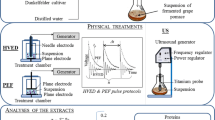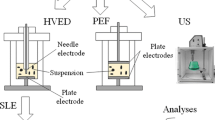Abstract
The moderate thermal (MT), ultrasound (US), and pulsed electric field (PEF) pretreatments are studied to enhance the phenolics extraction from Cabernet Franc (CF) grapes. The next pretreatment conditions are investigated: MT (50 °C, 15 min, 125 kJ/kg), US1 (24 kHz, 5 min, 121 kJ/kg), US2 (24 kHz, 10 min, 242 kJ/kg), US3 (24 kHz, 15 min, 363 kJ/kg), PEF1 (0.8 kV/cm, 100 ms, 42 kJ/kg), and PEF2 (5 kV/cm, 1 ms, 53 kJ/kg). The qualitative parameters of extracts (pH, °Brix, and color intensity), their total polyphenols content, anthocyanins, tannins, and free radical scavenging activity were determined during the whole period of alcoholic fermentation. The results show that all studied pretreatments improve phenolics extraction (anthocyanins and tannins content), color intensity, and scavenging activity of the samples during red fermentation. However, the moderate (0.8 kV/cm) and high (5 kV/cm) PEF were the most effective pretreatments and increased the phenolics extraction yield, respectively, on 51 and 62 %, while the MT and US3 pretreatments increased the phenolics extraction yield, respectively, on 20 and 7 %. The anthocyanin and tannins were also better extracted, and the color intensity was highest after the PEF pretreatments in comparison with the MT and US pretreatments.









Similar content being viewed by others
Abbreviations
- MT:
-
Moderate thermal
- US:
-
Ultrasound
- PEF:
-
Pulsed electric field
- CF:
-
Cabernet Franc
- DM:
-
Dry matter
- GAE:
-
Gallic acid equivalent
- DPPH:
-
1,1-Diphenyl-2-picrylhydrazyl
- OD:
-
Optical density
- CI:
-
Color intensity
- SO2 :
-
Sulfur dioxide
- HCl:
-
Hydrochloric acid
- R 2 :
-
Linear regression coefficient
- d :
-
Distance between electrodes (cm)
- E :
-
Electric field strength (V/cm)
- n :
-
Number of pulses
- N :
-
Number of trains
- T :
-
Time (min)
- t i :
-
Pulse duration (µs)
- t PEF :
-
Effective time of PEF treatment (s)
- Δt :
-
Time between pulses (ms)
- Δt t :
-
Pause after each train (s)
- m :
-
Mass of grapes (kg)
- U :
-
Voltage (V)
- W :
-
Energy consumption (kJ/kg)
- Y 0 :
-
Initial content of total phenolic compounds (mg GAE/100 g DM)
- Y t :
-
Content of total phenolic compounds at t (mg GAE/100 g DM)
References
Jackson RS (2000) Wine sciences: principles, practice, perception, 2 nd edn. Academic Press, San Diego
Shi J, Yu J, Pohorly JE, Kakuda Y (2003) Polyphenolics in grape seeds-biochemistry and functionality. J Med Food 6:291–299
Monagas M, Bartolome B, Gomez-Cordoves C (2005) Updated knowledge about the presence of phenolic compounds in wine. Crit Rev Food Sci Nutr 45:85–118
Pinelo M, Arnous A, Meyer AS (2006) Upgrading of grape skins: significance of plant cell-wall structural components and extraction techniques for phenol release. Trends Food Sci Technol 17:579–590
Sun BS, Spanger MI, Roque-Do-Vale F, Leandro MC, Belchior AP (2001) Effect of different winemaking technology on phenolic composition in Tinta Miuda red wines. J. Agri Food Chem 49:5809–5816
Sacchi KL, Bisson LF, Adams D (2005) A review of the effect of winemaking techniques on phenolic extraction in red wines. Am J Enol Vitic 56:197–206
López N, Puértolas E, Condón S, Álvarez I, Raso I (2008) Effects of pulsed electric fields on the extraction of phenolic compounds during the fermentation of must of Tempranillo grapes. Innov Food Sci Emerg Technol 9:477–482
Parenti A, Spugnoli P, Calamai L, Ferrari S, Gori C (2004) Effects of cold maceration on red wine quality from Tuscan Sangiovese grape. Eur Food Res Technol 4:360–366
Kelebek H, Canbas A, Cabaroglu T, Selli S (2007) Improvement of anthocyanin content in the cv. Okuzgozu wines by using pectolytic enzymes. Food Chem 105:334–339
Palma MM, Taylor LT (1999) Extraction of polyphenolic compounds from grape seeds with near critical carbon dioxide. J Chromatogr A 849:117–124
Delsart C, Ghidossi R, Poupot C, Cholet C, Grimi N, Vorobiev E, Milisic V, Mietton Peuchot M (2012) Enhanced extraction of valuable compounds from merlot grapes by pulsed electric field. Am J Enol, Vitic 11088
Boussetta N, Vorobiev E, Deloison V, Pochez F, Cordin-Falcimaigne A, Lanoisellé JL (2011) Valorisation of grape pomace by the extraction of phenolic antioxidants: application of HighVoltage Electrical discharges. Food Chem 128:364–370
Chemat F, Zill EH, Khan MK (2011) Applications of ultrasound in food technology: processing, preservation and extraction. Ultrason Sonochem 18:813–835
González MG, Usaquén-Castro X, Martínez RM, Aya-Baquero H (2006). Ultrasound-assisted Extraction of Polyphenols from Red-grape (Vitis Vinifera) Residues. 13th world congress of food science & technology
Cabredo-Pinillos S, Cedron-Fernandez T, Gonzalez-Briongos M, Puente-Pascual L, Saenz-Barrio C (2006) Ultrasound-assisted extraction of volatile compounds from wine samples: optimization of the method. Talanta 69:1123–1129
Corrales M, Toepfl S, Butz P, Knorr D, Tauscher B (2008) Extraction of anthocyanins from grape by-products assisted by ultrasonics, high hydrostatic pressure or pulsed electric fields: a comparison. Innov Food Sci Emerg Technol 9:85–91
Ghafoor K, Choi YH, Jeon JY, In HJ (2009) Optimization of ultrasound-assisted extraction of phenolic compounds, antioxidants, and anthocyanins from grape (Vitis vinifera) seeds. J Agric Food Chem 57:4988–4994
Novak I, Janeiro P, Seruga M, Oliveira-Brett A (2008) Ultrasound extracted flavonoids from four varieties of Portuguese red grape skins determined by reverse-phase high-performance liquid chromatography with electrochemical detection. Anal Chim Acta 630:107–115
Cocito C, Gaetano G, Delfini C (1995) Rapid extraction of aroma compounds in must and wine by means of ultrasound. Food Chem 52:311–320
Masuzawa N, Ohdaira E, Ide M (2000) Effects of ultrasonic irradiation on phenolic compounds in wine. Jpn J Appl Phys 39:2978–2979
Vinatoru M, Toma M, Mason TJ (1999) Ultrasonically assisted extraction of bioactive principles from plants and the constituents. Adv Sonochem 5:216
Paniwnyk L, Beaufoy E, Lorimer JP, Mason TJ (2001) The extraction of rutin from flower buds of sophora japonica. Ultrason Sonochem 8:299–301
Vorobiev E, Lebovka NI (2007) Extraction of intercellular components by pulsed electric fields. In: Raso J, Heinz V (eds) Pulsed electric field technology for the food industry. Fundamentals and applications, Springer, pp 153–194
Vorobiev E, Lebovka NI (2008) Pulsed electric field induced effects in plant tissues: fundamental aspects and perspectives of application. In: Vorobiev E, Lebovka N (eds) Electrotechnologies for extraction from food plants and biomaterials. Springer, Berlin, pp 39–82
Vorobiev E, Lebovka N (2010) Extraction from solid foods and biosuspensions enhanced by electrical pulsed energy (pulsed electric field, pulsed ohmic heating and high voltage electrical discharges). Food Engineering Reviews, no 2
Toepfl S, Heinz V, Knorr D (2006) Applications of pulsed electric field technology for the food industry. In: Raso J, Heinz V (eds) Pulsed electric field treatment of foods. Elsevier, Oxford, pp 197–221
Puértolas E, Saldaña G, Condón S, Álvarez I, Raso J (2010) Evolution of polyphenolic compounds in red wine from Cabernet Sauvignon grapes processed by pulsed electric fields during aging in bottle. Food Chem 119:1063–1070
De Vito F, Ferrari G, Lebovka N, Shynkaryk M, Vorobiev E (2008) Pulse duration and efficiency of soft cellular tissue disintegration by pulsed electric fields. Food Bioprocess Technol 1:307–313
Puértolas E, López N, Condón S, Álvarez I, Raso J (2010) Potential applications of PEF to improve red wine quality. Trends Food Sci Technol 21:247–255
Donsi F, Ferrari G, Fruilo M, Pataro G (2010) Pulsed electric field-assisted vinification of Aglianico and Piedirosso Grapes. J Agric Food Chem 58:11606–11615
Ratoarinoro CF, Wilhelm AM, Berlan J, Delmas H (1995) Power measurement in sonochemistry. Ultrason Sonochem 2:43–47
Glories Y (1984) La couleur des vins rouges: 11 partie ‘‘les équilibres des anthocyanes et des tanins. Connaissance Vigne Vin 18:195–217
Slinkard K, Singleton VL (1977) Total phenol analyses: automation and comparison with manual methods. Am J Enol Vitic 28:49–55
Ribéreau-Gayon P (1970) Le dosage des composés phénoliques totaux dans les vins rouges. Chimie Analytique 52:627–631
Ribéreau-Gayon P, Stonestreet E (1968) Les dosages des anthocyanes dans le vin rouge. Bull Soc Chim Fr 9:2649–2652
Ribéreau-Gayon P (1998) Traité d’oenologie, tome 2. Ed Dunod
Gyamfi MA, Yonamine M, Aniya Y (1999) Free-radical scavenging action of medicinal herbs from Ghana: thonningia sanguine on experimentally induced liver injuries. Gen Pharmacol 32:661–667
Zanoni B, Siliani S, Canuti V, Rosi I, Bertuccioli M (2010) A kinetic study on extraction and transformation phenomena of phenolic compounds during red wine fermentation. Int J Food Sci Tech 45:2080–2088
Amendola D, De Faveri DM, Spigno G (2010) Grape marc phenolics: extraction kinetics, quality and stability of extracts. J Food Eng 97:384–392
Bucic-Kojic A, Planinic M, Tomas S, Bilic M, Velic D (2007) Study of solid-liquid extraction kinetics of total polyphenols from grape seeds. J Food Eng 81:236–242
Tiwari BK, Patras A, Brunton N, Cullen PJ, O’Donnell CP (2010) Effect of ultrasound processing on anthocyanins and color of red grape juice. Ultrason Sonochem 17:598–604
Mikolajzack M, Veyret M, Williams P, Doco T, Escudier JL (2011) Jus de raisin: comment extraire le maximum du potentiel de la baie de raisin. Revu francaise d’œnologie 249:24–32
Rostagno MA, Palma M, Barroso CG (2003) Ultrasound-assisted extraction of soy isoflavones. J Chromatogr A 1012:119–128
Lecas M, Brillouet JM (1994) Cell wall composition of grape berry skins. Phytochemistry 35:1241–1243
Vorobiev E, Lebovka NI (2011) Pulse electric field assisted extraction. In: Lebovka N, Vorobiev E, Chemat F (eds) Enhancing extraction processes in the food industry. CRC Press, USA
Vilkhu K, Mawson R, Simons L, Bates D (2008) Applications and opportunities for ultrasound assisted extraction in the food industry e a review. Innov Food Sci Emerg Technol 9:161–169
Boulton R (2001) The copigmentation of anthocyanins and its role in the color of red wine: a critical review. Am J Enol Vitic. 52:67–86
Ribéreau-Gayon P (1982) The anthocyanins of grapes and wines. In: Markakis P (ed) Anthocyanins as food colors. Academic Press, New York, pp 209–244
Spigno GL, Tramelli L, De-Faveri DM (2007) Effects of extraction time, temperature and solvent on concentration and antioxidant activity of grape marc phenolics. J Food Eng 81:200–208
Patras Ankit, Brunton NP, O’Donnell C, Tiwari BK (2010) Effect of thermal processing on anthocyanin stability in foods; mechanisms and kinetics of degradation. Trends Food Sci Technol 21:3–11
Ducasse MA (2009) Impact des enzymes de macération sur la composition en polysaccharides et en polyphénols des vins rouges – étude de l’évolution de ces composés en solution modèle vin. Thèse de doctorat de l’université Montpellier II, Montpellier
Acknowledgments
The authors would like to thank the society KSARA (Lebanon) for financial support.
Author information
Authors and Affiliations
Corresponding author
Rights and permissions
About this article
Cite this article
El Darra, N., Grimi, N., Maroun, R.G. et al. Pulsed electric field, ultrasound, and thermal pretreatments for better phenolic extraction during red fermentation. Eur Food Res Technol 236, 47–56 (2013). https://doi.org/10.1007/s00217-012-1858-9
Received:
Revised:
Accepted:
Published:
Issue Date:
DOI: https://doi.org/10.1007/s00217-012-1858-9




